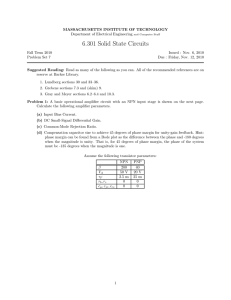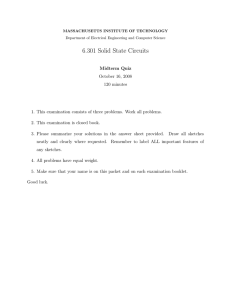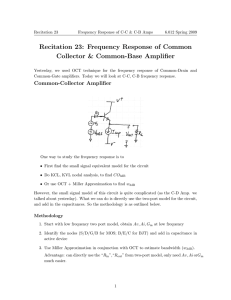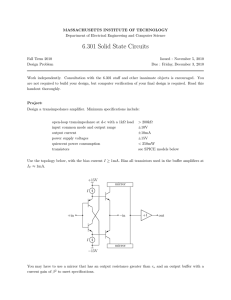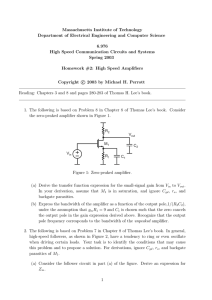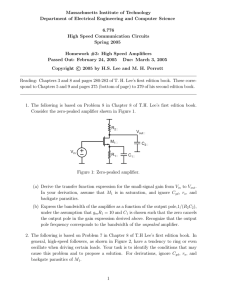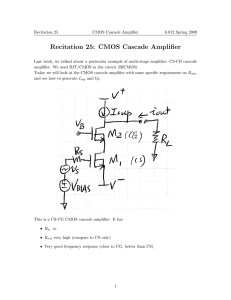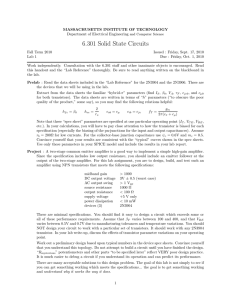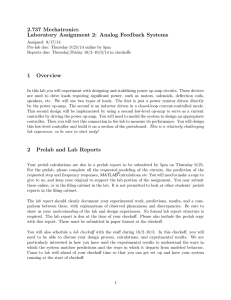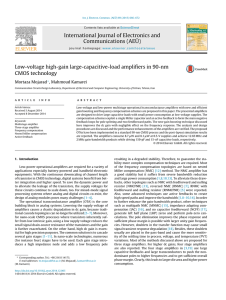Recitation 19: Common Emitter Amplifier Review: Small signal model of BJT
advertisement
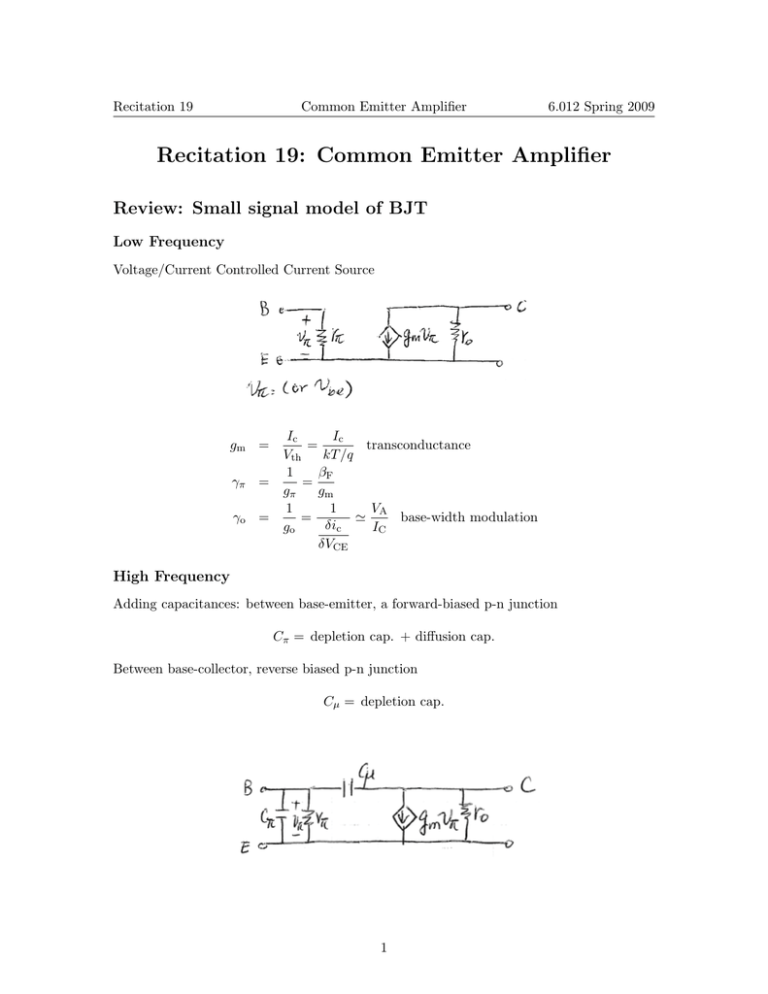
Recitation 19 Common Emitter Amplifier 6.012 Spring 2009 Recitation 19: Common Emitter Amplifier Review: Small signal model of BJT Low Frequency Voltage/Current Controlled Current Source gm = γπ = γo = Ic Ic = transconductance Vth kT /q 1 βF = gπ gm 1 1 VA = base-width modulation δic go IC δVCE High Frequency Adding capacitances: between base-emitter, a forward-biased p-n junction Cπ = depletion cap. + diffusion cap. Between base-collector, reverse biased p-n junction Cμ = depletion cap. 1 Recitation 19 Common Emitter Amplifier 6.012 Spring 2009 Transistor Amplifiers Yesterday we started our discussion on transistor amplifiers. For amplifiers, we have: Type Voltage Amplifier Current Amplifier Transconductance Amplifier Transresistance Amplifier Input V I V I Output V I I V Voltage and transconductance amplifiers are most common. Yesterday, we discussed the common-source amplifier shown below: 2 Recitation 19 Common Emitter Amplifier 6.012 Spring 2009 Today, we will discuss common-emitter amplifier (for the BJT version) Resistor Bias At Collector Current Source At Collector For amplifier circuits, what we are interested in are: • What is the operating point? (Bias point) • Signal Swing? • Small signal gain; input resistance; output resistance • Frequency Response Among these, first two are large signal analysis, while the last two are related to small signal circuits. 3 Recitation 19 Common Emitter Amplifier 6.012 Spring 2009 DC Bias Point For large signal analysis, Vs & Rs will be gone. Also make RL ∞. See figure 4, Vout = Vcc − Ic · Rc Vcc If we choose Vout = = 2.5 V (Vcc = 5 V), Rc = 10 kΩ 2 Vcc − Vout 5 V · 2.5 V Ic = = = 250 μA Rc 10 kΩ kT Ic Ic = Is eqVBIAS /kT =⇒ VBIAS = ln = 0.682 V q Is Signal Swing • Upswing limited by BJT going into cutoff: Total signal Vout,max = Vcc • Down swing limited by BJT going out of FAR into saturation Vout,min = VCE,SAT Small Signal Analysis of CE Amplifier First obtain the small signal circuit of the circuit in Figure 4 • Short DC voltage bias • Open DC circuit bias Intrinsic will be (without Rs and RL ) This is a transconductance amplifier, it turns out its small signal circuit is very similar to the topography of our “two port model” 4 Recitation 19 Common Emitter Amplifier 6.012 Spring 2009 In comparison, we see Rin = γπ Gm = gm = Ic kT /q Rout = γo ||Rc Intrinsic or unloaded gain (short circuit output) iout Gm Vin = = Gm Vin Vin And the loaded transconductance gain: iout Vs = Gm Vin · = Gm Rout Rout + RL Rout Rout+RL 1 Vs Rin γo ||Rc γπ Rin + Rs · Vs = gm γo ||Rc + RL γπ + R Vs Replacing Rc with a Current Source From the discussions in the above subsection, in general: ro Rc =⇒ ro ||Rc = Rc iout Rc rπ and = gm · rπ + R s vs Rc + R L If Rc RL or Rc < RL , transconductance gain is degraded. 5 Recitation 19 Common Emitter Amplifier 6.012 Spring 2009 So we need a large Rout (output is a current) =⇒ use a current source at the collector =⇒ Figure 5 can be a p-MOSFET, Rc → roc (in small signal circuit, DC current is open) On the CE Amp. We consider the CE Amp. to be a transconductance amplifier. In fact, it can also be just a voltage amplifier. In that case, the two port model becomes: 6 Recitation 19 Common Emitter Amplifier 6.012 Spring 2009 CS vs. CE Amp In comparison with the CS Amp we discussed yesterday: 2I D • VBIAS = + VSS + VT w μn Cox L w VDD (by letting VOUT = 0, & IR = ID = μn Cox (VBIAS − VSS − VT )2 = ) 2L RD • VOUT,MAX = VDD (MOS into cutoff) VOUT,MIN = VBIAS − VT (MOSFET leave saturation) • Rin = ∞, Rout = ro ||RD AVD = Vout Vs Vout = −gm (ro ||RD ) Vin = −gm (ro ||RD ||RL ) 7 MIT OpenCourseWare http://ocw.mit.edu 6.012 Microelectronic Devices and Circuits Spring 2009 For information about citing these materials or our Terms of Use, visit: http://ocw.mit.edu/terms.
